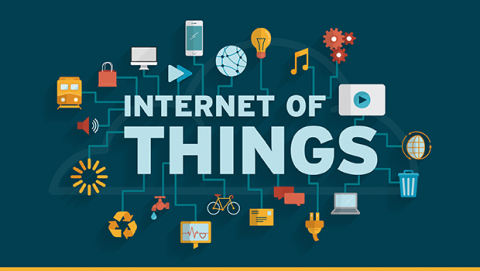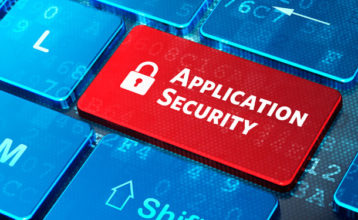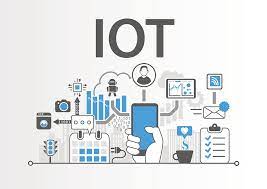Cyber, Internet, and your Pharmacy system security-Part III The Internet of Things (IoT)
- By
- Jonathan Jacobs
IoT
Just What is the Internet of Things?
The Internet of things, or IoT, is a system of interrelated computing devices, mechanical and digital machines, objects, animals or people that are provided with unique identifiers (UIDs) and the ability to transfer data over a network without requiring human-to-human or human-to-computer interaction.
A thing in the internet of things can be a person with a heart monitor implant, a farm animal with a biochip transponder, an automobile that has built-in sensors to alert the driver when tire pressure is low, or any other natural or man-made object that can be assigned an Internet Protocol (IP) address and is able to transfer data over a network.
The IoT ecosystem consists of web-enabled smart devices that use embedded systems, such as processors, sensors, and communication hardware, to collect, send and act on data they acquire from their environments. IoT devices share the data they collect by connecting to an IoT gateway or other edge device where data is either sent to the cloud to be analyzed or analyzed locally. In healthcare, this may often appear in the form of an RPM (Remote Patient Monitoring) system. A few examples of RPMs would be a pacemaker, glucose meter, CPAP machine, or a BP device that self-reports. Sometimes, these devices communicate with other related devices that use more powerful processors and algorithms and send back information for the device to act on the information they get from one another. The devices do most of the work without human intervention, although people can interact with the devices — for instance, to set them up, give them instructions or access the data. Many Pharmacies have blood pressure and weight kiosks designed to report to you AND to a central station or even your Pharmacy Management system. Warning signals can be sent or collected in various formats. Non-pharmacy examples in your home might be smart thermostats, doorbell cameras, and that smart smoker in your backyard that cooks up a nice brisket.
Why has the IoT (Internet of Things) become so important?
Over the past few years, IoT has become one of the most important technologies of the 21st century. Now that we can connect everyday objects—kitchen appliances, cars, thermostats, baby monitors—to the internet via embedded devices, seamless communication is possible between people, processes, and things.
Access to low-cost, low-power sensor tech.
Connectivity also costs less than it ever has to report or transfer data. Cloud computing platforms have allowed both businesses and consumers to have access to these tools without large scale up costs. Machines now have the ability to ‘learn’, in essence, the beginnings of AI (artificial intelligence). Lastly is Conversational artificial intelligence such as Alexa, Siri, Cortana, etc. This connectivity has crossed into all things related to our homes.
IoT is also being used to enhance our shopping experiences. This drives sales via smart displays and intelligent food presentations, opportunistic texts to shoppers, etc. Some of us have been to a store where coupons pop out or your phone buzzes with an ad or electronic incentive to purchase an item as you are browsing the store! This isn’t just an accident of immense coincidence I’m sure you realize? Currently, Walmart manages more than 7 million unique IoT data points across it’s U.S. stores. Every day, this network of connected devices sends almost 1.5 billion messages regarding temperature, operating functions, and energy use. To help manage this massive volume, the IoT team within Walmart Global Tech has built proprietary software that uses advanced algorithms to detect anomalous events in real-time and take action to fix or direct people to fix issues quickly.
IoT device trends and anticipated growth
The estimations for future growth of IoT devices have been fast and furious. At the high end of the scale, Intel projected that internet-enabled device penetration would grow from 2 billion in 2006 to 200 billion by 2020, which equates to nearly 26 smart devices for each human on Earth. A little more conservative, IHS Markit said the number of connected devices will be 75.4 billion in 2025 and 125 billion by 2030. By the end of this decade if not already, every new vehicle sold throughout the world has a device or several devices talking/communicating across different parts of the car and back to some central service. Certainly, all electric vehicles sold today have multiple reporting mechanisms with diagnostic information regarding your cars performance, maintenance, whereabouts, and how to be sure you make it to the next charging station if you push it to its limits like you used to when seeing how far below empty your could go before running out of fuel in your gas-powered vehicle.
A vulnerable device can be a security risk to your network, other devices, etc. by giving cybercriminals access to connected networks, enabling them to steal critical corporate data and user credentials. Early IoT devices didn’t fully understand the security necessary to secure them and the environments in which they operate. Organizations therefore must understand device security and specs, in order to secure IoT devices and networks, mitigating the potential vulnerabilities they face from deploying these tools.
IoT in HealthCare and Pharmacy
A Glance at The Benefits of IoT in Pharma Production
Immaculate production and quality control measures are an absolute must in the pharma industry. When you’re working with a potentially life-saving substance or device, anything could go wrong. However, introducing a network of connected devices with monitoring sensors can reduce the risk of machinery malfunctions and guarantee precision production by detecting issues and making adjustments before they cause a problem.
How IoT has positively impacted drug production and distribution straight to your store and then… your door.
- Industrial Mechanics and Maintenance Pharma IoT monitoring sensors can instantaneously feed all relevant facility data into a single dashboard, alerting a supervisor to abnormal conditions or to necessary maintenance requirements.
- Material Tracking & Management Tracking the source of supplies is important to maintaining quality and speed of production, and the potential risks of ingredient substitution, counterfeit medicines, or the theft of drugs can have serious consequences for a pharma company. RFID tags have now been put in place in many areas of production to eliminate errors and ensure pedigree post-production.
- Supply Chain and Logistics Tracking finished products throughout the supply chain provides enhanced control over your pharmaceutical or device inventory.
- Regulatory Compliance Consistency Chain of Command and Pedigree in Drug production has become quite important to all, especially in the distribution of LDDs (Limited Distribution Drugs) and Compounding ingredients.
- Rich Insight Into Production Process Health Data analytics software can determine what areas are most prone to issues, pinpoint inefficiencies, and potential cost overruns so that improvements can be put in place to boost productivity and profitability.
- Enhancing Patient Connectivity and Adherence** The second most important aspect of pharma IoT is its inherent impact on patient adherence and overall health. In this digital age, everything is technically enhanced, even prescription or OTC medications. RPM’s or Remote patient Monitoring as we’ve previously mentioned is now becoming the backbone of how technology benefits adherence.
-
Smart Pills and Implanted Devices (RPM’s) Leading pharmaceutical companies are using smart devices or RPM’s to administer medications and monitor their effect on patients. This includes the delivery of medications or medical monitors in “smart pills”.
Pharmacy Benefits of IoT
So to bring us full circle on how this relates to us all in our current state of affairs-vaccinations. When the Pandemic first began and Pfizer rolled out its vaccine there was particular concern regarding maintaining a certain temperature for storage and distribution. IoT provided the solution via “cold chain temperature monitoring”.
What is Cold Chain Temperature Monitoring?
Cold chain temperature monitoring is a set of equipment and production processes that allow for the tracking of products inside a particular container. A cold chain temperature monitoring system can be used to track the state and condition of perishable items during delivery or while in storage. Cold chain monitoring devices are exceptionally important to keep the products in their “usable” state and prevent them from spoiling or degrading in quality.
What Makes an IoT Device Vulnerable?
An IoT device typically lacks the required built-in security to counter security threats. Common vulnerabilities and exposures allow cybercriminals to breach the device and use it as a foothold to launch sophisticated cyberattacks. During the past couple of years, IoT came under vicious scrutiny due to its weak security. A vulnerable device can risk IoT security by giving cybercriminals access to connected networks, enabling them to steal critical corporate data and user credentials. Organizations therefore must understand how to secure IoT devices and recognize the top IoT vulnerabilities they face. Close to 70 percent of organizations suffered from an IoT-sourced cyberattack worldwide. The numbers are only expected to grow as IoT use increases, and hackers become more familiar and comfortable with the tech.
How to Keep IoT Safe
There are countless ways you can secure your network while utilizing/benefiting from IoT devices and minimize the risks. Some are more complex than others as they provide different levels of security.
- Skip All Defaults and Double-Down on Passwords The least you can do to ensure your IoT network and devices remain secure is to set strong passwords and usernames different from the default mode. As we’ve mentioned in Part II of this series a great place to manage, organize, and even produce passwords are apps/sites that like 1password.com or lastpass.com.
-
Use Multi-Factor Authentication MFA can be as simple as receiving a text or email message with a unique code every time you log in or generating a code natively on your smartphone—which are options for two-factor authentication.
-
Keep Software Up-to-Date Software updates aren’t just for a sleeker user interface or added features. They often fix old bugs and patch security vulnerabilities. Tools like McAfee LiveSafe or Total Protection let you know if many the applications you use have an update available.
-
Encrypt Your Connection When You Have to Go Online One of the simplest ways to secure browsing is using a VPN. A VPN changes a device’s IP address and encrypts all the data leaving it, creating an additional layer of security. This is really important when using free WiFi out in public or at an airport while traveling.
-
Secure Internet Connection For routers, replace the default network name, admin username, and password with secure alternatives and change them regularly.
-
Set a Monitoring System It’s essential to keep a close eye on the state of the devices and data flow. A monitoring system is a system that tracks your devices’ health and sends out alerts if anything is out of the ordinary.
-
Utilize Network Segmentation Network segmentation is the process of splitting an internal network into multiple, separate sub-networks. Each of the segments has related or dependent devices and they are segmented from those that aren’t. While the segments can communicate on occasion, they’re generally independent and isolated from one another. One example of this for your store would be segmenting the pharmacy systems from the POS systems. Another, more specific to IoT is to put any patient IoT devices you manage locally in a segment (sometimes called a DMZ) so the chance they could affect your other network systems is minimized.
- Focus on Flexibility and Scalability Switching to a smaller or larger network of IoT is inevitable as needs and budgets fluctuate. Having a flexible security system in place will allow for a smoother and safer transition when needed.
As we continue to move forward technologically, the importance of the IoT will become a larger and more acceptable part of our general social consciousness. Check back soon for the next part of (our now expanded) five-part series: Cyber, Internet, and your Pharmacy System’s Security!
Point of Care would like everyone to continue remaining compliant with mask-wearing where mandated and to vaccinating as required to help us all end the Covid-19 Pandemic.
Please click on the below-listed articles we’ve previously written regarding related material to our current series of reports and previously released parts I & II.
Cyber, Internet, and Pharmacy System Security Part I- Are you secure?
Remote Patient Monitoring is Here to Stay!
Cyber, Internet, and Pharmacy System Security Part II-Personal Security
In addition, we’ve listed a few additional articles regarding related topics for your reading enjoyment:
How Technology improves the lives of Seniors





